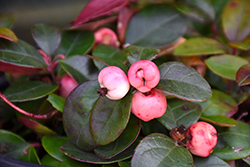It's all about ...
plants

Peppermint Pearl ™ Wintergreen
Gaultheria procumbens 'SpecGP11'
Height: 8 inches
Spread: 24 inches
Sunlight:
![]()
![]()
![]()
Hardiness Zone: 3a
Other Names: Checkerberry, Wintergreen
Description:
A good groundcover for highly acidic, sandy and poor soils, with dark green, glossy foliage; small white flowers in spring, followed by pearl white berries in fall, that mature to pink-red; extremely fragrant leaves smell like wintergreen when crushed
Ornamental Features
Peppermint Pearl ™ Wintergreen features dainty nodding white bell-shaped flowers at the ends of the branches from late spring to mid summer. It features an abundance of magnificent white berries from early fall to early winter, which fade to rose over time. It has dark green evergreen foliage. The fragrant oval leaves turn purple in the fall, which persists throughout the winter.
Landscape Attributes
Peppermint Pearl ™ Wintergreen is a spreading evergreen shrub with a ground-hugging habit of growth. Its relatively fine texture sets it apart from other landscape plants with less refined foliage.
This is a relatively low maintenance shrub, and should not require much pruning, except when necessary, such as to remove dieback. Deer don't particularly care for this plant and will usually leave it alone in favor of tastier treats. Gardeners should be aware of the following characteristic(s) that may warrant special consideration;
- Suckering
Peppermint Pearl ™ Wintergreen is recommended for the following landscape applications;
- Mass Planting
- Rock/Alpine Gardens
- General Garden Use
- Groundcover
Planting & Growing
Peppermint Pearl ™ Wintergreen will grow to be about 8 inches tall at maturity, with a spread of 24 inches. It tends to fill out right to the ground and therefore doesn't necessarily require facer plants in front. It grows at a medium rate, and under ideal conditions can be expected to live for approximately 10 years.
This shrub performs well in both full sun and full shade. It requires an evenly moist well-drained soil for optimal growth, but will die in standing water. It is very fussy about its soil conditions and must have rich, acidic soils to ensure success, and is subject to chlorosis (yellowing) of the foliage in alkaline soils. It is somewhat tolerant of urban pollution, and will benefit from being planted in a relatively sheltered location. Consider covering it with a thick layer of mulch in winter to protect it in exposed locations or colder microclimates. This is a selection of a native North American species.
